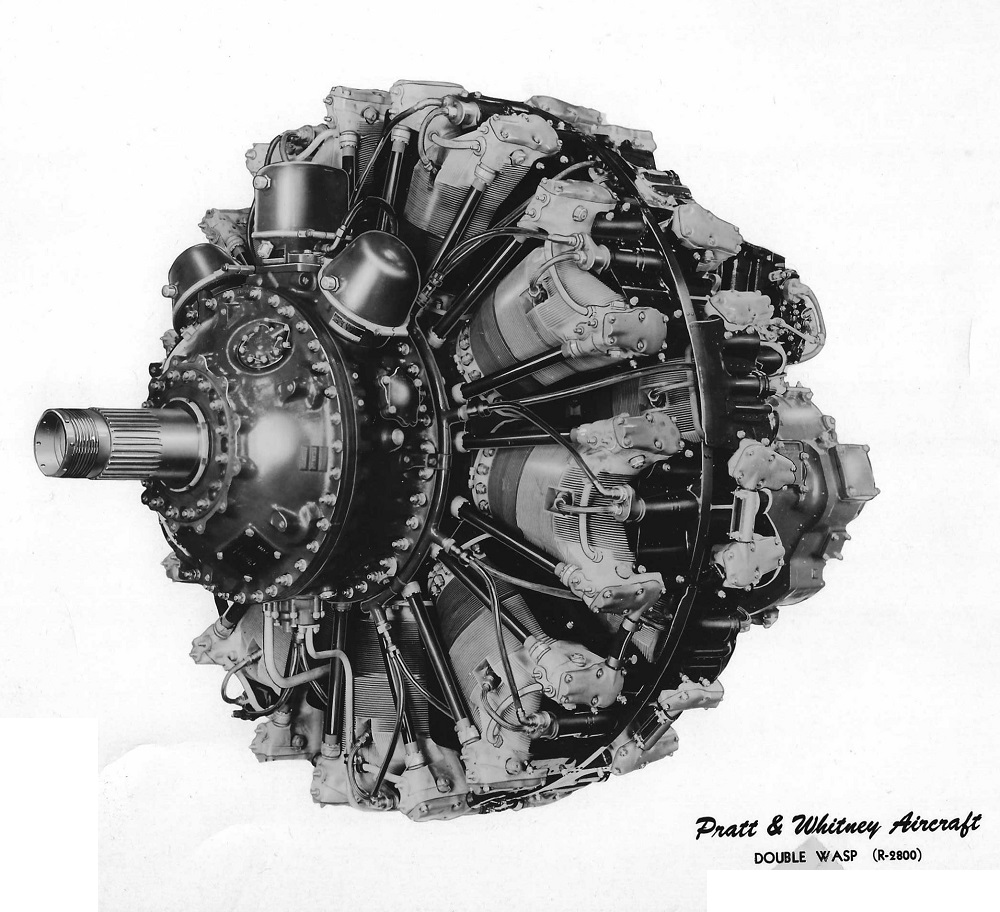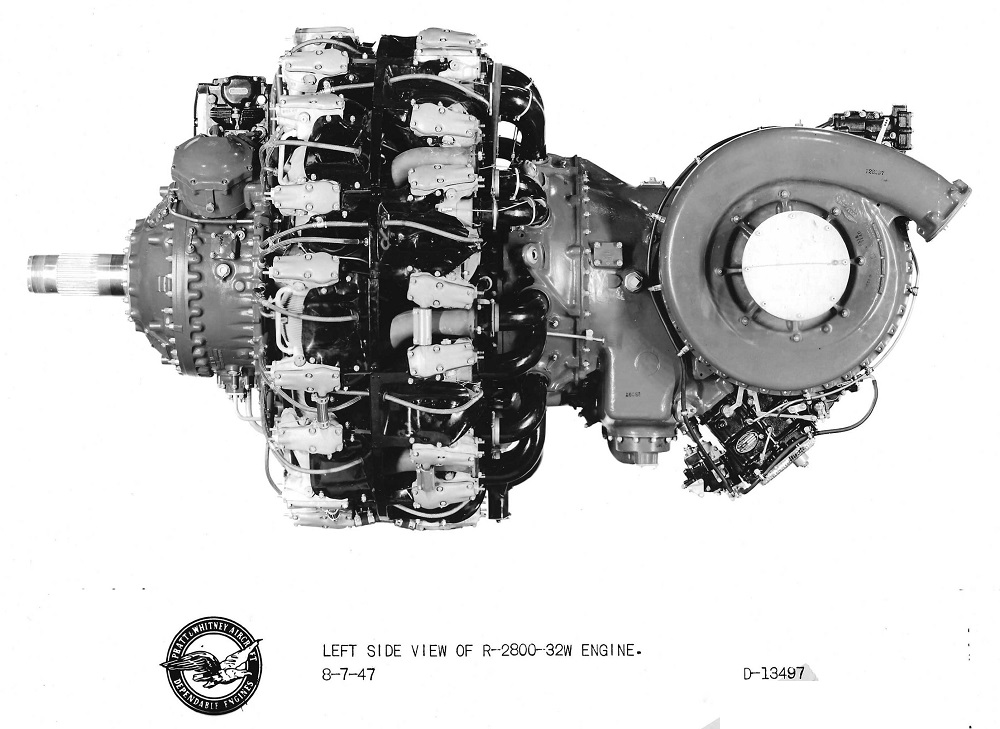
|
 |
|
|---|---|---|
| |
| |

Pratt and Whitney's R-2800 engine was America's first 18 cylinder radial that produced a maximum of 3,400 hp (2,535 kW). |
|
Pratt and Whitney's R-2800 (46 L) Double Wasp was America's first 18-cylinder radial engine. Although much smaller than the world's only other modern 18-cylinder engine, the 3,442 cu in. (56.4 L) Gnome-Rhone 18L, it was nevertheless more powerful. While the Gnome-Rhône 18L produced 1,300 hp (970 kW), the R-2800 averaged 2,000 hp (1,490 kW). By 1950, the engine was able to produce 2,400 hp (1,790 kW) and with water injection as high as 3,400 hp (2,535 kW) for emergency combat conditions.1 Heat dissipation was correspondingly more of a problem for radial engines and this meant that for the R-2800, the cast or forged cooling fins of previous designs had to be discarded. Cooling fins needed to be so thin and of such a fine pitch that they had to be machined from a solid metal forged head. The fins were cut together by a gang of automatically guided milling saws that rose and fell following the head contour. The results were worth the trouble as it was a case of designing an engine component that could only be made by a new method. In addition to the new head design, the Double Wasp had a very efficient baffling system to direct the flow of cooling air that was considered even better than the excellent arrangements on the Ranger inline air-cooled engines.2
 (Photo: NEAM Ramsay Research Library) 2,000 hp (1,490 kW) was obtained from the R-2800 with 1 hp/1.4 cu in. (43.6 hp/L) of displacement. In 1939, when the R-2800 was introduced, no other air-cooled engine came close to this figure, and even liquid-cooled ones barely matched it.3 The designing of conventional air-cooled radial engines had become so scientific and systematic by 1939 that the Double Wasp was introduced at a power rating that was not amenable to anything like the developmental power increases that had been common with earlier engines. It went to 2,100 hp (1,565 kW) in 1941 and to 2,400 hp (1,790 kW) late in the war, but that was all for production models. Experimental models, as always, were coaxed into giving more power, one fan-cooled subtype producing 2,800 hp (2,090 kW), and considerably more (up to 3,600 hp (2,685 kW)) on dynamometers. Technicians at the Republic Aircraft Corporation ran the engine at extreme boost pressures at 3,600 hp (2,685 kW) for 250 hours without any failure using common 100 octane avgas, but in general, the R-2800 was a rather fully developed powerplant right from the beginning. It was exclusively a powerplant for fighters and medium bombers during the war, being used in the Republic P-47 Thunderbolt, Grumman F6F Hellcat, Vought F4U Corsair, Northrop P-61 Black Widow and also in the Martin B-26 Marauder and Douglas A-26 Invader twin-engine medium bombers. Post-war its reliability commended its use for long-range patrol planes and for the Douglas DC-6, Martin 404, and Convair transports. The Convair application is noteworthy, since these were twin-engine craft of size, with passenger capacity, and high wing loading that was comparable with the DC-4 and the first Lockheed Constellations. Two engines were all right for transports as with the Douglas DC-3's moderate wing loading, and the high wing loading of the Douglas DC-4 was safe enough when there were four engines, but all that weight with only two engines seemed like tempting fate. However, the Convair engineers knew what they were doing. (Those at Martin, and those who tested the Martin for government approval didn't—the Martin's wings failed from fatigue after a while.) The Convair transports were just as good in their way as the four-engine transports. A well-engineered installation and good controls were probably what made the difference. When the USA went to war in December 1941, there were some major changes in philosophy. Such long-established engines as the Cyclone and Twin Wasp were re-rated on fuel of much higher anti-knock value to give considerably more power. Perhaps the most outstanding example was the great R-2800 Double Wasp, which went into production in 1940 for the B-26 Marauder at 1,850 hp (1,380 kW) and by 1944 was in service in late model P-47 Thunderbolts (and other aircraft) at a rating of 2,800 (experimental) hp (2,090 kW) on 115-grade fuel with water injection. Of course, all engines naturally grow in power with development, but a major war demands the utmost performance from engines fitted to aircraft, whose life in front-line service was unlikely to exceed 50 hours' flying time over a period of only a month or two. In peace time, the call was for reliability over a period of perhaps a dozen years. And of course a pilot in combat has no time to fiddle endlessly with a fistful of engine controls in order to maintain the optimum engine operating conditions, and bearing in mind the rate at which aircrews had to be produced in wartime, he probably did not have the knowledge and experience of how to do this anyway. |
| Specifications: | |
|---|---|
| Pratt and Whitney R-2800 Double Wasp | Date: | 1939 |
| Cylinders: | 18 |
| Configuration: | Double row radial, Air cooled |
| Horsepower: | 2,000 hp (1,490 kw) |
| R.P.M.: | 2,400 |
| Bore and Stroke: | 5.8 in. (146 mm) x 6 in. (152 mm) |
| Displacement: | 2,800 cu. in. (46 liters) |
| Weight: | 2,350 lbs. (1,068 kg) |
Endnotes:
1. The Pratt & Whitney Aircraft Story. Pratt & Whitney: 1950. 11.
2. Herschel Smith. A History of Aircraft Piston Engines. Manhattan, Kansas: Sunflower University Press, 1993. 121.
3. Howard Mingos, ed. The Aircraft Year Book for 1942. New York: Aeronautical Chamber of Commerce of America, Inc., 1942. 371.
© The Aviation History Online Museum. All rights reserved.
Created September 23, 1996. Updated August 18, 2024.